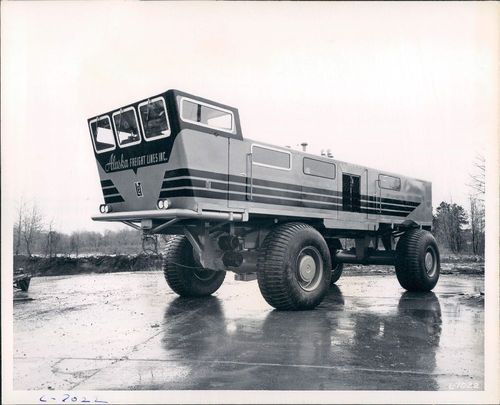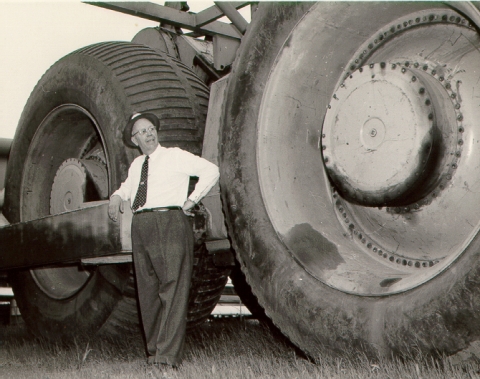During the cold war, the U.S. Army needed to build 78 radar stations to warn against a Soviet first strike attack. Furthermore, they needed to build them in a hurry. Unfortunately, the radar stations were to be located in the remotest part of northern Alaska. In fact, the area was so far removed from civilization there were no roads, no rail connections, and very few airstrips necessary for moving construction supplies.
The question, then, was how to transport the men and materials needed to build the DEW (or Distant Early Warning) line of radar stations? The surrounding terrain was so rough a single supply trip could take three months. Meanwhile temperatures in winter dropped to 68 degrees below zero. It wasn't going to be easy.
The solution was a new kind of off-road vehicle purpose-built to navigate harsh terrain. Designed by Robert LeTourneau and his Longview, Texas-based company, LeTourneau Technologies, the new vehicle was nicknamed the Sno-Freighter. Not surprisingly, it turned out to be one of the damnedest looking things anyone had ever seen (see photos above and below).
The Sno-Freighter, or Model VC-22 as it was designated, was a 274-foot-long "train" with a locomotive cab and five trailer cars. Each trailer was capable of carrying 25 tons of supplies for a total payload of 150 tons. The 24-wheeled vehicle was operated by a four-man crew, and not only didn't need paved roads (or iron rails) to cross the Alaskan tundra, it could ford rivers up to four feet deep.

LeTourneau was an interesting character in his own right (see photo below). A cross between Red Adair and a Christian missionary, he had extensive experience building heavy equipment for the public and private sectors. In addition to designing world class earth movers, he'd created such exotic military vehicles as a mobile launcher for the Corporal missile (the first nuclear-tipped, surface-to-surface, guided missile), and a huge mobile crane designed to remove incapacitated bombers from a runway when time was of the essence. But more about him later.

LeTourneau built the Sno-Freighter in early 1955. After shipping it in pieces to Circle City, Alaska the Sno-Freighter was assembled and in the field in less than six days. To see a lovely, if all too brief, film of the Sno-Freighter undergoing an early outdoor test, click here. Another short video with a look inside the locomotive cabin appears here.
One of the most notable features of the Sno-Freighter were its electric motors located at each one of the vehicle's 24 wheels. Powered by two, 400 hp Cummins engines, the electric motors allowed each wheel to be driven independently of the others. It was a revolutionary innovation, and it made LeTourneau rich and famous.
As a result of its tremendous size, the Sno-Freighter had an enormous tire-area to vehicle-weight ratio which provided superior traction compared to Admiral Byrd's Antarctic Snow Cruiser (see previous posting). It was the just right specification for traversing the Alaskan wilderness.
The Sno-Freighter performed well in its first season becoming one of the earliest wheeled vehicles to drive from Fairbanks, Alaska to the Arctic Ocean. However, during its second winter it was involved in an accident, partially burned, and had to be abandoned. Subsequently, Alaska Freight Lines, the company that leased the Sno-Freighter to deliver DEW construction supplies to the Army, went bankrupt.
But that wasn't the end of Letourneau's amazing land trains nor of the DEWs pioneering supply line. In fact, it was just the beginning.
To be continued...
Images used with explicit permission.